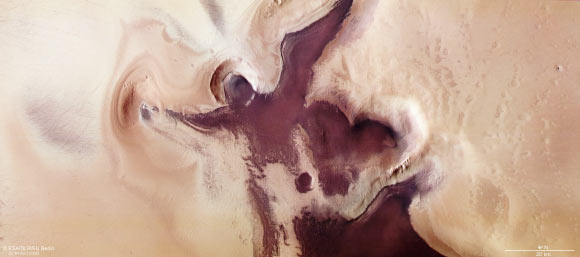The new image was acquired by the High Resolution Stereo Camera (HRSC) onboard Mars Express on November 8, 2020.
It shows dune fields and several periglacial formations in the southern polar region of Mars, with the pole itself located directly out of frame to the right.
The region is typically covered in a 1.5 km-thick ice cap measuring around 400 km across and with a volume of 1.6 million km3, just over 12% of which is water ice.
The rest of the cap is largely composed of solid carbon dioxide, which freezes from the atmosphere during winter and then sublimates in the summer.
As Mars’ southern hemisphere is currently experiencing summer, the new mage shows the planet’s southern polar ice stores at their lowest annual levels.
Continued...
Source
It shows dune fields and several periglacial formations in the southern polar region of Mars, with the pole itself located directly out of frame to the right.
The region is typically covered in a 1.5 km-thick ice cap measuring around 400 km across and with a volume of 1.6 million km3, just over 12% of which is water ice.
The rest of the cap is largely composed of solid carbon dioxide, which freezes from the atmosphere during winter and then sublimates in the summer.
As Mars’ southern hemisphere is currently experiencing summer, the new mage shows the planet’s southern polar ice stores at their lowest annual levels.
Continued...
Source






















